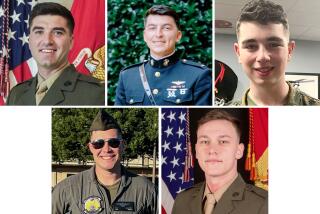Hornet Will Stalk the Night : Aircraft: An El Toro Marine fighter attack squadron proudly unveils the F/A-18D night-attack jet. It’s the first operational squadron to take possession of the newly configured plane.
- Share via
EL TORO — The camouflage net covering came off. Simultaneously, the military band struck up a spirited rendition of the theme from the motion picture “Star Wars.”
And little wonder that song was picked.
For underneath the covering, a sleek, futuristic airplane came into view on Friday afternoon. Before an invited audience of news media and special guests, the Marine Corps Air Station here proudly presented its F/A-18D Hornet. The ceremony marked the first time in the nation the fighter plane has been turned over to an operational squadron.
“Today marks the beginning of a new era in Marine Corps aviation,” said Lt. Col. Gayle E. Adcock, commander of El Toro’s All-Weather Fighter-Attack Squadron 121. “The 121, the Marine Corps’ most highly decorated squadron, becomes the first operational unit to fly the F/A-18D night-attack Hornet.”
The Marine Corps emphasized night-attack in describing this new version of the McDonnell Douglas aircraft. The F/A-18D is a two-seat plane specially built for flying when most everyone else is asleep. Its on-board, “Star Wars”-like electronic equipment is augmented by special night-vision goggles for the the front-seat pilot and the back-seat weapons-system officer.
The two advances--more night flying capability and enhanced use of night goggles--inevitably brought questions from the news media on hand to see the roll-out ceremony. Would the plane cause more noise problems for nearby communities? And are these night goggles safe, in view of the problems Marine helicopter pilots have had with another version of night goggles?
Marine officials emphatically responded that the plane would cause no additional noise problems, primarily because most of its expanded night flying would be from remote fields out in the desert. The officials also said the night goggles for the plane’s crew are “a new generation” of the device and are safe.
“We’ve never had a fixed-wing aircraft accident in the Marine Corps due to night goggles,” said base spokesman Maj. Jim McClain. As for noise, he added, “the night missions will be conducted away from the El Toro area. There will be no increase in the noise level.”
Adcock, the squadron commander for the new plane, talked of it like a father describing a son who plays football for USC.
“It can turn like you wouldn’t believe,” Adcock said. “It can go anywhere, at any time. It’s like going from a VW Bug to a Rolls-Royce. That’s the kind of difference you notice in flying this.” Other Marine pilots on hand for the ceremonies also had grins as they viewed the new plane.
One crew--Maj. Jeffrey White, 35, a weapons-system officer from Columbus, Ohio, and his pilot, Maj. John Rader, 35, Berryville, Ark.--stood near the newly unveiled plane.
Rader solemnly became very military as he told a reporter why he likes the new plane. “The air frame itself is good, and it’s got a large flight envelope,” Rader said. “It’s a fourth-generation fighter. It’s got a multi-role: It can do strikes and support Marines on the ground, plus it’s got the air-to-air fighter role. And then we add a navigation infrared system, and then we wear night-vision goggles, which allows us to support the Marines on the ground.”
When asked to describe his feelings about the plane in layman’s language, Rader grinned and said: “It’s a great airplane. It’s like getting a new car. It’s like smelling a new car. There’s nothing like it. These planes are really nice.”
The plane used for the ceremony is designated for use by Cmdr. Adcock, and it had his name painted by the pilot’s seat. But during the presentation Friday, another flight crew--Capt. Phil Browning, 31, of Oxon Hill, Md., and Capt. David Wilson, 32, of Birmingham, Ala.--sat in the plane’s two seats and talked to visitors who climbed a ladder to inspect the aircraft’s cockpit.
Browning good-naturedly agreed to put on the weird-looking night-vision goggles. He quickly became the most photographed person at the ceremony. “Don’t smile, Phil,” yelled one of his fellow officers. “You’re supposed to look serious.”
Most of the ceremony was, in fact, very serious about why the plane is being introduced into the Marine Corps’ weapons system. Officials said the plane, which will replace the squadron’s A-6 aircraft, enhances the Marines’ ability to fly anywhere, anytime, regardless of darkness or weather.
Said Maj. Gen. Royal N. Moore Jr.: “We’ve got the equipment to do the job.”
Gen. Joseph Went, the assistant commandant of the Marine Corps, viewed the assemblage Friday and pronounced it pleasing.
“All you Marines are looking good out there,” Went said. “We’re proud of you.”


